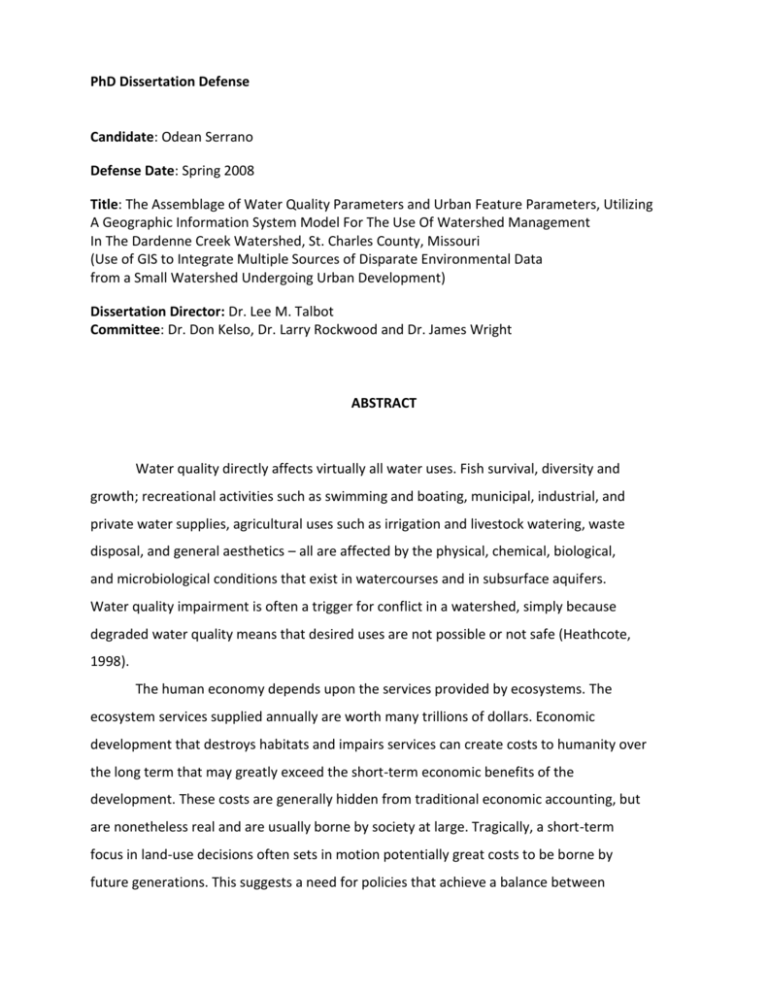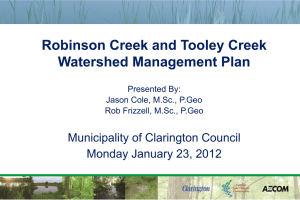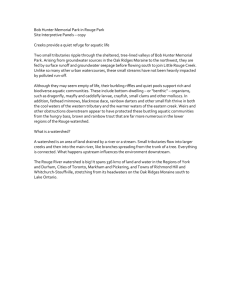The assemblage of water quality parameters and urban feature
advertisement

PhD Dissertation Defense Candidate: Odean Serrano Defense Date: Spring 2008 Title: The Assemblage of Water Quality Parameters and Urban Feature Parameters, Utilizing A Geographic Information System Model For The Use Of Watershed Management In The Dardenne Creek Watershed, St. Charles County, Missouri (Use of GIS to Integrate Multiple Sources of Disparate Environmental Data from a Small Watershed Undergoing Urban Development) Dissertation Director: Dr. Lee M. Talbot Committee: Dr. Don Kelso, Dr. Larry Rockwood and Dr. James Wright ABSTRACT Water quality directly affects virtually all water uses. Fish survival, diversity and growth; recreational activities such as swimming and boating, municipal, industrial, and private water supplies, agricultural uses such as irrigation and livestock watering, waste disposal, and general aesthetics – all are affected by the physical, chemical, biological, and microbiological conditions that exist in watercourses and in subsurface aquifers. Water quality impairment is often a trigger for conflict in a watershed, simply because degraded water quality means that desired uses are not possible or not safe (Heathcote, 1998). The human economy depends upon the services provided by ecosystems. The ecosystem services supplied annually are worth many trillions of dollars. Economic development that destroys habitats and impairs services can create costs to humanity over the long term that may greatly exceed the short-term economic benefits of the development. These costs are generally hidden from traditional economic accounting, but are nonetheless real and are usually borne by society at large. Tragically, a short-term focus in land-use decisions often sets in motion potentially great costs to be borne by future generations. This suggests a need for policies that achieve a balance between sustaining ecosystem services and pursuing the worthy short-term goals of economic development. These ecological costs must be understood and harnessed as a variable in determining the long term effects to our communities at the local level. The Dardenne Creek watershed is located in St. Charles County, Missouri, the fastest growing county in the St. Louis metropolitan area for three decades and one of the largest counties in metro St. Louis (St. Charles County Development, 2007). The central part of the watershed contains a large portion of the most rapidly developing belt of St. Charles County (University of Missouri, Columbia: Center for Applied Research and Environmental Systems (CARES), 2003). Dardenne Creek, selected for this study, and its tributaries drain almost 30% of the area of St. Charles County (U.S. Army Corps of Engineers, 2007). Many of the largest and quickest growing cities in the county contribute runoff to Dardenne Creek. Therefore, with more people moving into the area every year, there is a potential increase in the number of homes located within and near the floodplain of Dardenne Creek and its tributaries. This extreme increase of residential and commercial building is what some residents and agencies say is the cause of heavy sediment loads causing harm to the creek. As such, the watershed has been studied by multiple stakeholders and governmental agencies which include detailed work gathering biological and chemical water quality parameters. The Army Corps of Engineers completed a three year watershed study in May 2007 -- that was ten years in the making -- compiling a hydrological assessment which included: land-use, land-cover, soil profiles, and updating the flood plain profiles. Although this recent hydrological watershed study has been derived, and over 20 years of water quality data gathered, a Watershed Management Plan has not yet been adopted. This dissertation intends to show how the assembly and manipulation of watershed data into a GIS format could facilitate stakeholder understanding and development of a rational watershed management plan. To illustrate how this can be done, and to make a significant initial contribution to this objective, this dissertation includes the assembly of chemistry, biological, data water quality data sets from 1983 and 1993-2007, using a Geographic Information System (ArcGIS©), overlaying the St. Charles County, Missouri urban features data set. This work also summarizes the relevant EPA Clean Water Regulations and the St. Charles County Watershed Management studies that have been conducted to date. The scope of this study includes the complexities and solutions for the integration of science and policy. The primary focus of this paper is to exemplify the need for an interconnected, multi-variable, and multi-disciplinary system, which enables and facilitates enhanced, holistic watershed management decisions.








